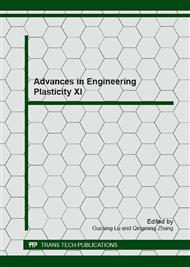p.453
p.457
p.461
p.465
p.469
p.473
p.477
p.481
p.485
Cooling Tower Shell under Asynchronous Kinematic Excitation Using Concrete Damaged Plasticity Model
Abstract:
The paper presents the analysis of the dynamic response of a cooling tower to moderate earthquake. To represent inelastic behavior of the concrete material of the tower under dynamic loading, the concrete damaged plasticity constitutive model was assumed. The model consists of the combination of non-associated multi-hardening plasticity and scalar damaged elasticity to describe the irreversible damage that occurs during the fracturing process. Two different models of seismic excitation were used. Initially, a classical model of uniform kinematic excitation was applied. In this model it was assumed that excitation at all supports was identical. Then, a model of non-uniform kinematic excitation, typical for large multiple-support structures, was introduced. In that model the wave passage along the foundation ring was taken into account. It occurred that the assumption of asynchronous excitation led to the increase of the dynamic response of the tower with respect to the assumption of uniform ground motion. The tensile damage (cracking) in some parts of the tower appeared and the stiffness of the concrete was degraded when non-uniformity of excitation was considered. This was due to the quasi-static effects resulting from changes of subsoil geometry during the shock. The analysis indicated that the classical assumption of uniform excitation may lead to non-conservative assessment of the dynamic response of the shell described with concrete damaged plasticity model.
Info:
Periodical:
Pages:
469-472
Citation:
Online since:
January 2013
Authors:
Price:
Сopyright:
© 2013 Trans Tech Publications Ltd. All Rights Reserved
Share:
Citation:


